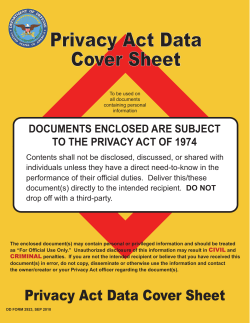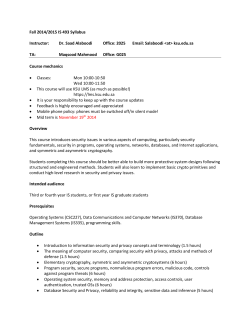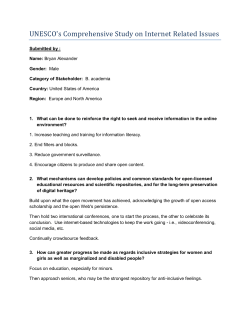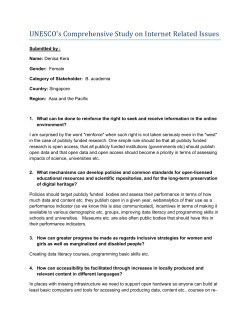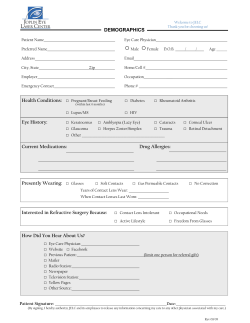
Influence of Users` Privacy Risks Literacy on the
Influence of Users’ Privacy Risks Literacy
on the Intention to Install a Mobile Application
Alessio De Santo and Cédric Gaspoz
Information Systems and Management Institute, HES-SO // University of Applied Sciences
Western Switzerland, HEG Arc, Neuchâtel, Switzerland
{alessio.desanto,cedric.gaspoz}@he-arc.ch
Abstract. While users are increasingly embracing smartphones worldwide,
these devices, storing our most personal information, are repeatedly found to be
leaking users’ data. Despite various attempts to inform users of these privacy
issues, they continue to adopt risky behaviors. In order to better protect users of
these devices, we need to understand the antecedents of the decision to install
potentially privacy-threatening applications on them. We ran a large experiment
in order to determine the influence of privacy risks literacy on the intent to
install a potentially privacy threatening application on a smartphone. Using
partial least squares (PLS), we were able to find that more than the privacy risks
literacy, it is the coping behavior literacy that influences the user’s decision to
install a mobile application. These findings are relevant to help determine a
course of action in order to increase the user’s privacy protection when using
such devices.
Keywords: Privacy risk literacy, coping behavior, smartphone, protection
motivation theory.
1
Introduction
More and more people are adopting smartphones worldwide. Agenda, address book,
email reader, camera, versatile storage and GPS are all integrated in these devices.
However, while conveniently storing our personal data, these devices can turn out to
be silently leaking our private information. Stories of devices leaking personal
information to third parties such as network operators, application developers,
advertisers and device manufacturers appear frequently in the headlines. Recent
results from online social networks show that users’ intentions to install potentially
privacy-invasive applications are influenced by the perceived benefits and risks
resulting from their use, which are in turn moderated by the privacy controls provided
to the user by the application. However, in the context of mobile device applications,
the user may be unaware of the privacy invasiveness of an application that is able to
access stored personal data for other purposes without the user’s knowledge.
Due to the very nature of smartphone applications, we need to rethink how we
assess the way people are interacting with them. When purchasing a smartphone,
people not only buy a physical device, but they can then access hundreds of thousands
© Springer International Publishing Switzerland 2015
Á. Rocha et al. (eds.), New Contributions in Information Systems and Technologies,
Advances in Intelligent Systems and Computing 353, DOI: 10.1007/978-3-319-16486-1_33
329
330
A. De Santo and C. Gaspoz
of applications through various online stores. The goal of these stores is to profit from
enhancing the user experience on the device and to provide additional resources to
device manufacturers or operating system developers. However, while selling
applications with low price tags, application developers are encouraged to embed
additional features in order to increase their revenues, mostly by reselling consumer
profiles. One can argue that people are nowadays generally aware of these practices,
since they are in widespread use on the mainstream Web.
However, a significant difference between using mobile applications and browsing
the Web is that on the latter, people are more conscious of the information they are
providing to third parties. When readers want to access newspaper websites, for
example, they are required to provide personal information (for example a valid email
address or some demographic information) and they are informed, for example
through terms and conditions, that this information can be stored by the proprietor of
the website or resold to third parties. In the case of mobile applications, the user
already has a lot of personal information stored on the device for various purposes.
When installing a new application, that application will request rights to access
smartphone functions such as network access, access to stored personal information,
access to capture devices, etc. Thus, by installing the application, the user is granting,
consciously or unconsciously, access to the personal information stored on the device.
To understand user decision making in this context, we need to study how user
privacy threats and coping behaviors literacy influences the perceived benefits of
using a specific application. Protection motivation theory (PMT) postulates that
attitude change is a function of the amount of protective motivation aroused by the
cognitive appraisal processes [11]. Both threat and coping appraisal cognitive
processes are triggered by information gathered from a variety of sources, which
could be environmental or intrapersonal, and the threat appraisal process can also be
initiated by a ‘fear appeal’. We postulate that, in the context of choosing to install a
mobile application, the principal source of information that triggers the cognitive
appraisal processes is the users’ literacy on privacy risks and coping behaviors. In
order to understand the influence of the users’ privacy risks and coping literacy on the
intent to install a specific application, we set up an experiment in which we
manipulated the users’ privacy risk literacy. This experiment showed that varying this
literacy impacts the users’ intent to install a given application.
2
Privacy Protection
The advent of the information age, the widespread use of the Internet to communicate,
share or exchange information, and advances in mobile computing have given rise to
concerns over violation of user privacy. Consequently, information privacy has
become one of the core topics in information systems (IS) research [14]. For our
research, we use the Stone et al. (1983) [18] definition of information privacy as ‘the
ability (i.e. capacity) of the individual to control personally (vis-à-vis other
individuals, groups, organizations, etc.) information about one’s self.’ This led us to
Influence of Users’ Privacy Risks Literacy on the Intention to Install a Mobile Application 331
differentiate two ways of controlling personal information: (1) restricting the
information we share and (2) restricting the way that information is shared.
Research into users’ intent to install applications or technologies that may carry
privacy risks is presented in the leading IS journals and conferences. The applications
studied include electronic health records [2], e-commerce [12], direct marketing [17],
home computing [1], radio frequency identification [9] and social networks [3]. A
recent review of information privacy research [16] reviewed all publications on
privacy in management information systems and concluded that ‘positivist empirical
studies will add the greatest value if they focus on antecedents to privacy concerns
and on actual outcomes’. They found that few researchers studied both the
antecedents and the outcomes of privacy concerns; most publications study either the
effects of antecedents on privacy concern or the effects of privacy concerns on
outcome.
Studies addressing this topic often rely on the theory of planned behavior, the
theory of reasoned action, rational choice theory, general deterrence theory or the
theory of protection motivation. However, the majority of these studies made some
assumptions as to the ability of the user to make an informed decision in these privacy
risk contexts and found that users tended to underestimate the threat to their
information security. However, none of the research tests the root cause of this failure
to correctly assess information security threats. A partial explanation of the fact that
people can be concerned about their privacy and at the same time readily hand over
sensitive personal information, comes from Bennett (2011) [4] who conceptualized
the notion of privacy as a commodity. ‘Under the commodity view, privacy is still an
individual and societal value, but it is not absolute, as it can be assigned an economic
value and be considered in a cost–benefit calculation at both individual and societal
levels’ [16]. However, in the context of mobile applications, there is a gap between
the valuation of information stored on the phone (for example in case of theft or loss
of the device) and users’ perceived valuation of the privacy risks associated with
those applications. This gap can therefore not be fully explained by the commodity
view; further explanation could include the cognitive process itself, the lack of
information available to application users or simply by the users’ overconfidence in
their own capabilities.
The protection motivation theory (PMT) [11] postulates that first information is
received. Then this information initiates a cognitive mediating process. This process
evaluates the response options toward the perceived situation. Finally, the result of
these mediating processes, the threat appraisal and the coping appraisal, determines
the reaction toward the situation. In this theory, information sources are the input
variables of the model and are categorized as environmental and intrapersonal.
Environmental sources being composed by verbal persuasion and observational
learning. The intrapersonal information sources include personality characteristics and
prior experience. Thus, by studying information sources, we can understand the user
behavior when confronted with the intention to install a new application on a
smartphone.
332
3
A. De Santo and C. Gaspoz
Hypotheses Development
In order to study the intention to install an application on a smartphone, we will study
the influences of the protection motivation process and the mobile application’s
characteristics on users’ decisions. We seek to understand the effect of the protection
motivation on the intention to install a particular smartphone application. In this
context, we postulate that the higher the protection behavior, the lower is the intent to
install the applications that could potentially be privacy threatening. We also postulate
that the intrinsic characteristics of a particular application will have some moderating
effects on the intent to install it. Again, as the risk rises, the intention will decrease.
H1: Users’ privacy risk literacy will be negatively correlated to the intention to
install an application
H2: Users’ coping behavior literacy will be positively correlated to the intention
to install an application
H3: Application’s potential risks toward the users’ privacy will be negatively
correlated to the intention to install an application
As stated above, PMT describes how the sources of information and the fear appeal
influence the development of protection behavior. The information is used during two
cognitive processes: threat appraisal and coping appraisal. In PMT, both processes are
direct antecedents of the protection behavior. Environmental information includes
verbal persuasion and observational learning. In the context of this study, we will only
study observational learning. We postulate that verbal persuasion will be part of the
experiment, given that participants are told that, in order to support the development
of mobile applications, they will have to decide which application will have the best
chances on the markets. Thus, given the experimental protocol used, we assume an
equal effect on all participants. To operationalize observational learning, we
differentiate coping behaviors and privacy risks literacy. These two constructs
summarize the extent of literacy in both domains. As PMT makes the difference
between threat and coping appraisal, we will measure each one independently.
The second type of source of information is the intrapersonal one. This source
comprises personality aspects, as well as prior experience with related situations. In
order to measure intrapersonal information, we use the reflective global information
privacy concern (GIPC) construct. This allows us to measure the user’s past
experience with the transmission of privacy related information. This construct will
directly influence the attitude of the user, the privacy risk literacy and the coping
behavior. A higher concern about information privacy should influence negatively the
intention to install a privacy threatening application and should reflect a better literacy
in both risks and coping behaviors.
H4: Global information privacy concern will be positively correlated to the
privacy risks literacy
H5: Global information privacy concern will be negatively correlated to the
intention to install an application
H6: Global information privacy concern will be positively correlated to the
coping behaviors literacy
Influence of Users’ Privacy Risks Literacy on the Intention to Install a Mobile Application 333
Applications’
characteristics
Privacy risk literacy
H4(+)
H1(−)
Global information
privacy concern
H3(−)
Intention to install
the application
H5(−)
H2(+)
H6(+)
Coping behavior
literacy
Fig. 1. Proposed research model
The final research model (Figure 1) clearly represents the antecedents of the
intention to install and use smartphone applications. This intention depends on the
application characteristics, users’ privacy risks literacy, users’ coping behaviors
literacy and users’ global information privacy concern.
4
Methodology
In order to explore our model (Figure 1), we conducted an experiment during which
users’ privacy risks literacy and applications’ characteristics were variable. The
experiments consisted of a height sections survey subjected to 1200 people. The
survey was introduced as a preliminary project to determine the criteria of adoption of
a fictive mobile tourist application. The first section was a basic demographic survey
including questions concerning the use of smartphones. Section 2 measured the GIPC
of the respondents. To measure the GIPC, we used an existing and approved scale
[17]. In section 3, the respondents’ privacy risk literacy was measured, followed by
the coping behavior literacy in section 4. Section 5 presented two possible scenarios
of our application, a low privacy threatening scenario and a high privacy threatening
scenario. Each scenario was characterized by expected features and required
permissions. The respondents had to rate their intention to install the application on a
five-point Likert scale. In section 6, the respondents’ privacy risk literacy was
manipulated. A recent article from a reputable newspaper was presented to the
respondent. In the article, the author presented the privacy risks of applications’
permissions acceptance and illustrated it with the very popular Facebook Messenger
application. In order to test their understanding of the texts, we asked each subject
three comprehension questions about the text they had just read. After the
manipulation, the subject was then again asked to read the descriptions of two mobile
applications scenarios (one application presenting high privacy risks and the other
presenting low privacy risks) and to decide if they would install them on their mobile
334
A. De Santo and C. Gaspoz
device. Finally, in section 8 we measured the respondents’ privacy risk literacy again,
with the same measurement items as in section 4 but shuffled. The respondents were
remunerated for their work.
To measure the impact of the manipulation, 307 surveys were allocated to a control
group. In this group, the manipulation text was replaced by a simple and nonmanipulating article relating the success story of a similar tourism application in a
European country.
4.1.1 Users’ Privacy Risk Literacy Measurement
Based on the Google Android developer documentation, we retrieved all the existing
mobile application permissions. Permissions accessing to private data were selected
and categorized in seven different groups of data. Tests of correlation were used to
ensure these categories were mutually exclusive. Finally corresponding privacy
questions (Q1 to Q7 in Table 1) were formulated to measure the users’ privacy risk
literacy.
Table 1. Users’ privacy risk literacy measurement items
Privacy risk issues
Category
Android Permissions
(Q1) It is likely that your movements
are recorded and relayed
Location
(Q2) It is likely that your
smartphone’s settings and status are
relayed
System
settings and
status
(Q3) It is likely that an application
retrieves the entire list of your contacts
(Q4) It is likely that your messages
and social streams are browsed, to
extract potential confidential
information
(Q5) It is likely that your user profile
and interests are analyzed and relayed
Profile and
contacts
Messages
and social
access_coarse_location,
access_fine_location,
access_location_extra_command,
access_mock_location,
access_wifi_state, battery_stats
get_tasks, read_phone_state,
read_sync_settings,
read_sync_stats
get_accounts, read_contacts,
read_call_log,
read_sms, read_social_stream,
read_user_dictionary
(Q6) It is likely that the content of
your smartphone’s agenda is relayed
(Q7) It is likely that the publisher of
the application accesses the pictures
and videos stored on your smartphone
Calendar
read_profile,
subscribed_feeds_read,
read_history_bookmarks,
read_calendar
Audio, photo
and video
record_audio, camera,
read_external_storage
User profile
and interests
4.1.2 Coping Behavior Literacy Measurement
Based on the privacy risk literacy measurement item, we developed the coping
behavior literacy measurement items.
Influence of Users’ Privacy Risks Literacy on the Intention to Install a Mobile Application 335
Table 2. Users’ coping behavior measurement items
Coping behavior
(Q8) It is effective to block communication networks to
prevent data transfers
(Q9) ... to paste a sticker on my camera so it does not
capture photos / videos without my knowledge
(Q10) ... to control my bills in order to detect anomalies
(Q11) ... to encrypt my data to make it unreadable to
malicious persons
(Q12) ... to deny access to the data stored on my phone
(Q13) ... to control the transfer of data over Internet
Privacy risks
Q1–Q7
Q7
Q1–Q7
Q4, Q6, Q7
Q1–Q7
Q1–Q7
4.1.3 Applications’ Characteristics
In order to determine low and high privacy threatening permissions, we conducted an
experiment involving a common application scenario and several sets of permissions
associated. The sets of permissions were mostly elaborated in regard to the
application features but also including some unrelated and therefore privacy
threatening permissions (from Table 1). The experiment came up with two sets of
permissions that were generally considered to be ‘low’ privacy threatening and two
others that were generally perceived as ‘high’ privacy threatening.
The experiment consisted of asking participants to rank eleven sets of permissions
developed, on a three-level scale going from totally acceptable to totally
unacceptable. In order to avoid any bias due to systematic reflection, the order of the
permissions in the different sets was shuffled. No logical structure or sequence of
permission could therefore have been detected. Moreover, all of the statement sets
contained similar numbers of words, with four or five permission statements in each.
The authors then ranked these eleven sets based on their level of threat (low, middle,
high) having reached agreement on the content.
For each set of permissions presented, we measured the behavioral intent,
prediction and plan to install the application on a five-point Likert scale, from
‘strongly agree’ to ‘strongly disagree’. The question on planning to install the
application was inverted, that is, measuring the intent to not install, in order to check
the validity of the survey [10].
5
Data Analysis
We used various techniques to clean the collected data. The first one eliminated all
the respondents who completed the survey in less than 4 minutes; this was considered
the minimum time to comprehend the experiment. The second filter consisted of a
reverse record check [13] on the four applications’ installation proposals. We then
used the comprehension questions asked at the end of section 6 to eliminate further
336
A. De Santo and C. Gaspoz
records. The last filter retained only people who owned a Google Android
smartphone, in order to ensure understanding of the problem by the respondents.
After this cleaning process, 426 records remained exploitable.
The final demographic data of the participants are shown in Table 3. The majority
of them are male undergraduates between 26 and 35. Almost all the participants
(93.9%) had at least six months’ experience with a smartphone. All the participants
currently own a Google Android smartphone (due to the data cleaning process).
Table 3. Demographic information
# of participants
Gender
Male
Female
Age
18–25
26–35
36–45
46–55
older than 56
Education
Primary School Degree
High School Degree
Certificate / Diploma Degree
Bachelor Degree
Master Degree
Doctorate
Global experience with a smartphone
Less than 6 months
From 6 to12 months
From 1 to 2 years
From 2 to 3 years
More than 3 years
Percentage (%)
301
125
70.65
29.34
93
156
127
32
18
21.83
36.62
29.81
7.51
4.23
12
135
96
131
48
4
2.82
31.69
22.54
30.75
11.27
0.94
26
43
80
86
191
6.10
10.09
18.78
20.19
44.84
Partial least squares (PLS) [6], a variance-based structural equation modelling
(SEM) analysis technique [5], was used for assessing our model and hypothesis. Since
the aim of our research was to predict an intention and not to confirm a theory or a
phenomenon, the use of PLS–SEM was suitable [15]. Users’ risks privacy literacy,
users’ coping behavior literacy, demographic information and applications
characteristics were each conceptualized as first-order formative constructs. Users’
GIPC and intention to install the application were conceptualized as first-order
reflective constructs.
Composite reliability scores of the reflective constructs were all above 0.70,
confirming the validity of these. The Applications’ Characteristics being a single-item
construct, the conventional reliability and convergent validity assessments were
inappropriate.
Influence of Users’ Privacy Risks Literacy on the Intention to Install a Mobile Application 337
Table 4. Formative constructs before/after manipulation
Group
Items
5.1
S.D.
Weight
Q1
Q2
Q3
Q4
Q5
Q6
Q7
3.23/3.54
3.53/3.58
3.65/3.80
3.40/3.63
3.23/3.42
3.03/3.40
3.48/3.74
1.28/1.34
1.35/1.44
1.21/1.26
1.32/1.40
1.38/1.42
1.43/1.46
1.23/1.24
Q8
Q9
Q10
Q11
Q12
Q13
3.42
3.15
3.56
3.89
3.70
3.71
1.06
1.45
1.16
1.13
1.06
1.05
Users’ risk
privacy
literacy
from 1 (very
unlikely)
to 5 (very
likely)
Users’ coping
behavior
literacy
from 1 (very
ineffective)
to 5 (very
effective)
Mean
Group
Group
Mean
S.D.
−0.10/0.66
3.36/
1.32/
0.61/1.48
3.59
1.37
0.20/0.42
−1.26/−0.57
0.15/-0.65
1.25/0.67
−0.28/−1.46
0.10/0.45
0.24/−0.11
−0.51/−1.11
0.88/0.47
0.46/0.19
−0.16/0.12
3.57
1.15
Effects of the Manipulation
Before any manipulation, we predicted that the likelihood of a subject intending to install
an application was 17.3%, based on the coping behavior literacy, the users’ privacy risk
literacy, the GIPC and the applications’ characteristics. The users’ coping behavior
literacy was the most influential construct, exerting a positive influence of 24.2% versus
the negative influence of 5.4%, 18.7% and 22.0% of the applications’ characteristics, the
users’ privacy risk literacy and GIPC. It was also interesting to note that the GIPC
determined 14.1% of the users’ privacy risk literacy, with 37.6% of influence.
T-statistics were used to test the proposed hypotheses for the standardized path
coefficients, by specifying the same number of cases that existed in the dataset and
bootstrapping 500 re-samples. The model fit was determined through strong path
coefficients significant at p<0.01. One-tailed t-tests were used, as the hypotheses were
all direction specific.
R²=0.104
Applications’
characteristics
Privacy risk literacy
H4
0.322***
H1
−0.156*
Intention to install
the application
H5
−0.378***
Global information
privacy concern
H2
0.323***
H6
−0.054
H3
−0.121*
R²=0.341
Coping behavior
literacy
R²=0.003
*** p < 0.01, ** p < 0.05, * p < 0.1
Fig. 2. Model results after manipulation
338
A. De Santo and C. Gaspoz
After the users’ privacy risk literacy manipulation, the intention to install an
application was predicted at 34.1% by the coping behavior literacy, the users’ privacy
risk literacy, the GIPC and the applications’ characteristics. In other words, we almost
doubled the prediction of the intention to install the application, and the elements
were 16.9% more predictive than before the manipulation. In that assertion, the GIPC
was the most influencing construct with a negative influence of 37.8%, followed by
the users’ coping behavior literacy with a positive influence of 32.3%, the users’
privacy risk literacy with a negative influence of 15.6% and finally the applications’
characteristics with a negative influence of 12.1%. The GIPC influences significantly
the users’ privacy risk literacy but not the users’ coping behavior literacy, which
suggests that something else influences the users’ coping behavior literacy, it could
certainly be the behavioral experience, but this is beyond the scope of this study. The
weight of each item demonstrated the item’s contribution to the construct. We
retained non-significant indicators to preserve content validity [5].
Table 5. Descriptive statistics, psychometric measurement validation and correlations for reflective
measures
Indicator
GIPC
Intention to
install the
application
gipc_1
gipc_2
gipc_3
install_1
install_2
install_3inv
Indicator AVE
Reliability
0.67
0.78
0.81
0.86
0.97
0.97
0.98
0.96
Composite
Reliability
0.91
Discriminant
Validity
Yes
0.99*
Yes
As explained above, we had two reflective constructs: GIPC and the intention to
install the application. The reliability and validity of the reflective measures were
achieved (composite reliability (CR) > 0.70); average variance extracted (AVE) >
0.50) (see Table 5). The square root of the AVE for each construct was greater than
the correlations with other factors, which means that the satisfactory discriminant
validity was also achieved (see Table 5), and the cross-loadings show each item
loading higher on its own factor than on others (see Table 6).
Table 6. Loadings and cross-loadings for reflective measures
Indicators
gipc_1
gipc_2
gipc_3
install_1
install_2
install_3inv
GIPC
0.820
0.901
0.929
−0.442
−0.428
−0.442
Intention to install an
application
−0.318
−0.366
−0.469
0.986
0.988
0.982
Influence of Users’ Privacy Risks Literacy on the Intention to Install a Mobile Application 339
6
Discussion
For the first time, a study examines the antecedents of the intention to install an
application on smartphones. Results are interesting, given that we are able to predict
more than 34% of the intention with our constructs. Following our intuition, H1, H2
and H3 are all verified. This allows, for the first time, to use PMT in order to
enlighten the tradeoffs between privacy risks and intention to install an application.
Past researchers have examined this question through the lens of privacy calculus
theory [7], which includes information disclosure as a tradeoff of benefits and risks.
Here we are able to use objective information in order to predict the intention. Indeed,
benefits and risks, especially with sensitive information, are very difficult to assess.
How valuable is my email address, my mobile phone number, or my current
localization? It is very difficult to make an objective evaluation of the value of this
information. It is also challenging to estimate the expected benefits from the use of a
given application. Therefore, by using objective evaluations of one’s literacy in
privacy risks and coping behavior we have a much more appropriate prediction of
one’s intention to use a mobile application. Moreover, by predicting more than 34%
of the intention, our model opens new opportunities to develop programs and policies
to increase the protection of smartphone users.
The second assumption that we made in our model is that protection motivation
and, ultimately, intention to use an application are user dependent. We cannot expect
all users to have the same sensitivity regarding their personal information. Some are
happy to share it in exchange for some sort of service while other will probably never
trade it. Our hypotheses H4, H5 and H6 validate that GIPCs have a direct influence
on the privacy risks literacy, the intention to install an application and on the coping
behavior literacy. Given that all three hypotheses are verified, we can validate our
global approach in prediction users’ intention in this context.
The results of our study provide evidence that as the level of users’ privacy risk
literacy increases, the protection motivation report increases and directly impacts on
the willingness to install or use an application. Our findings also suggest that
increases in users’ privacy risk literacy increases the influence of the characteristics of
the application. Simply stated, users who are more conscious of the privacy risks are
less prone to install an application independently of the characteristics of the
application. Therefore, to protect users from confidential data loss, it would be
effective to act on their privacy risk literacy.
These results are very interesting as they validate our assumption that, in the
context of mobile applications, the privacy as a commodity view [4] could no longer
hold, as the users are no longer aware of the magnitude of private information that
they share with application editors. Thus, we need to further study the implications of
users’ literacy on their decisions to install and use mobile applications, in order to
better protect smartphone users against unintentional leakage of private information.
Moreover, this could also assist OS editors in developing some sort of risk training in
their software in order to increase the privacy risks literacy for their user base.
There are many opportunities to further explore this subject. It seems that very
often the awareness context [8] of the user in deciding to install a mobile application
340
A. De Santo and C. Gaspoz
is very low. This is not because the risk information is unavailable, but because most
users do not bother to consult it, or they simply do not want to know about it. We
need to further study the awareness context of the users, as well as the antecedents to
a move from one context to the other. Using the awareness context theory in future
research on privacy risks with mobile applications should help researchers to
understand how users are evaluating their trust in application developers. This should
then help policymakers in designing public awareness campaigns on mobile
applications’ privacy risks.
7
Conclusion
This study presents a new model to predict the user’s intention to install a smartphone
application based on PMT. Validated by a large experiment, our model uses objective
measures of the privacy risks literacy and the coping behavior literacy in order to
predict the intention to install an application with specific characteristics. This model
voluntarily departs from the traditional risks/benefits explanation of these behaviors,
given that first, users are unable to assess the value of both risks and benefits, and
second, that the risk may occur long after the installation of the application.
We suggest that this model can be used to develop more effective ways to help
users of these devices to protect their privacy. This is a necessary advance, given the
increased amount of information that is stored on smartphones. With the evolution of
the technology, more and more people are storing medical records captured by
external sensors or financial transactions carried out through mobile payment services
that have a high value for resellers of personal profiles. By showing the antecedents of
the intention, our model will assist policymakers and developers in protecting
smartphone users from increased attempts to access their personal information.
References
1. Anderson, C.L., Agarwal, R.: Practicing safe computing: a multimedia empirical
examination of home computer user security behavioral intentions. MIS Q 34(3), 613–643
(2010)
2. Angst, C.M., Agarwal, R.: Adoption of electronic health records in the presence of privacy
concerns: the elaboration likelihood model and individual persuasion. MIS Q 33(2), 339–370
(2009)
3. Bélanger, F., Crossler, R.E.: Privacy in the digital age: a review of information privacy
research in information systems. MIS Q 35(4), 1017–1042 (2011)
4. Bennett, C.: In defense of privacy: the concept and the regime. Surveill 8(4), 485–496
(2011)
5. Bollen, K., Lennox, R.: Conventional wisdom on measurement: A structural equation
perspective. Psychol. Bull. 110(2), 305–314 (1991)
6. Chin, W.W.: Commentary: Issues and Opinion on Structural Equation Modeling. Manag.
Inf. Syst. Q. 22(1), vii–xvi (1998)
7. Dinev, T., Hart, P.: An Extended Privacy Calculus Model for E-Commerce Transactions.
Inf. Syst. Res. 17(1), 61–80 (2006)
Influence of Users’ Privacy Risks Literacy on the Intention to Install a Mobile Application 341
8. Glaser, B.G., Strauss, A.L.: Awareness Contexts and Social Interaction. Am. Sociol.
Rev. 29(5), 669–679 (1964)
9. Günther, O., Spiekermann, S.: RFID and the perception of control. Commun. ACM. 48(9),
73–76 (2005)
10. Johnston, A.C., Warkentin, M.: Fear appeals and information security behaviors: an
empirical study. MIS Q 34(3), 549–566 (2010)
11. Maddux, J.E., Rogers, R.W.: Protection motivation and self-efficacy: A revised theory of
fear appeals and attitude change. J. Exp. Soc. Psychol. 19(5), 469–479 (1983)
12. Malhotra, N.K., et al.: Internet Users’ Information Privacy Concerns (IUIPC): The
Construct, the Scale, and a Causal Model. Inf. Syst. Res. 15(4), 336–355 (2004)
13. Öztaş Ayhan, H., Işiksal, S.: Memory recall errors in retrospective surveys: A reverse
record check study. Qual. Quant. 38(5), 475–493 (2005)
14. Pavlou, P.A.: State of the information privacy literature: where are we now and where
should we go? MIS Q 35(4), 977–988 (2011)
15. Ringle, C.M., et al.: Editor’s comments: a critical look at the use of PLS-SEM in MIS
quarterly. MIS Q. 36(1), iii–xiv (2012)
16. Smith, H.J. et al.: Information Privacy Research: An Interdisciplinary Review. MIS Q.
35(4), 989–1015 (2011)
17. Smith, H.J. et al.: Information Privacy: Measuring Individuals’ Concerns about
Organizational Practices. MIS Q. 20(2), 167–196 (1996)
18. Stone, E.F., et al.: A field experiment comparing information-privacy values, beliefs, and
attitudes across several types of organizations. J. Appl. Psychol. 68(3), 459–468 (1983)
© Copyright 2025

